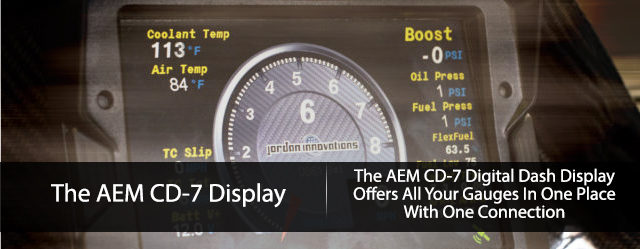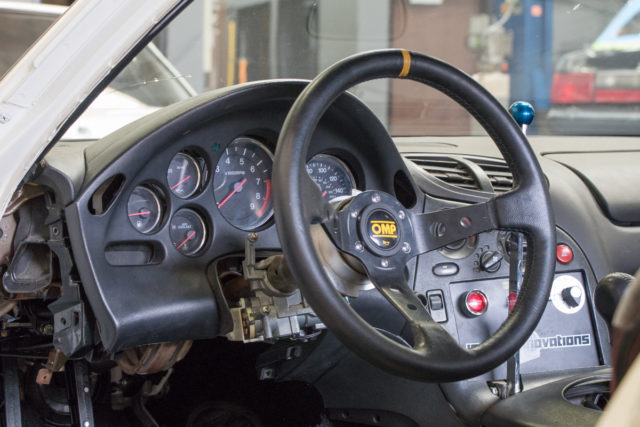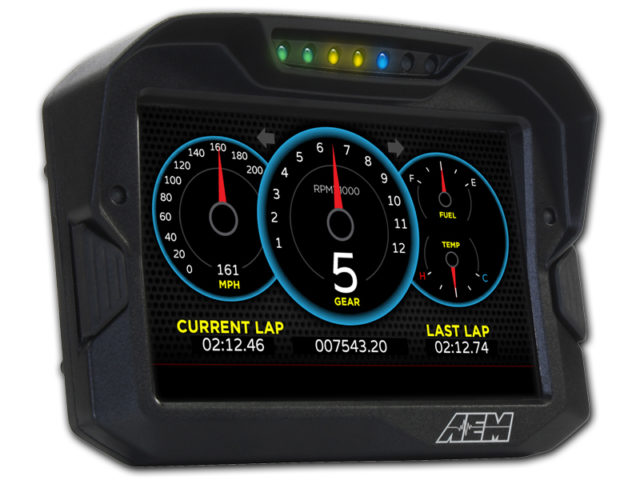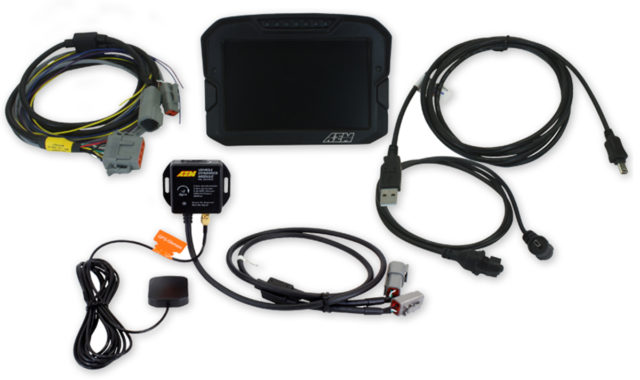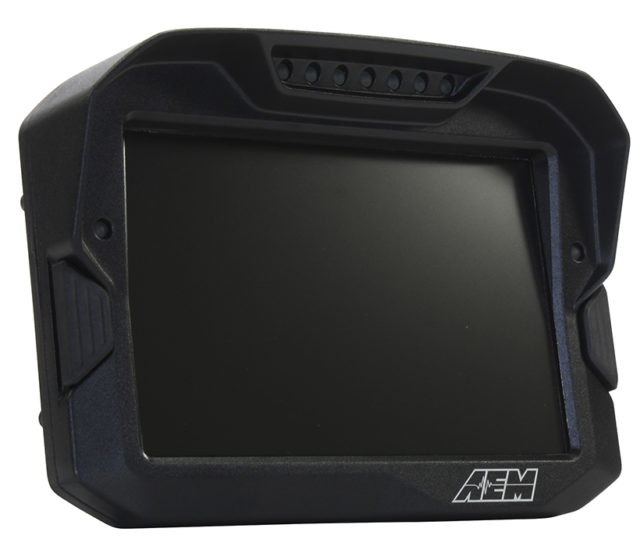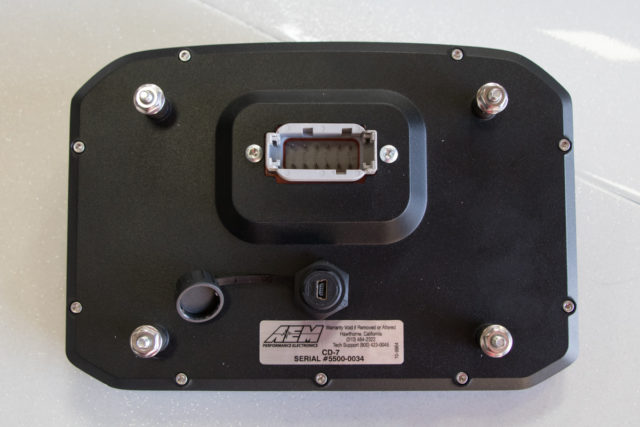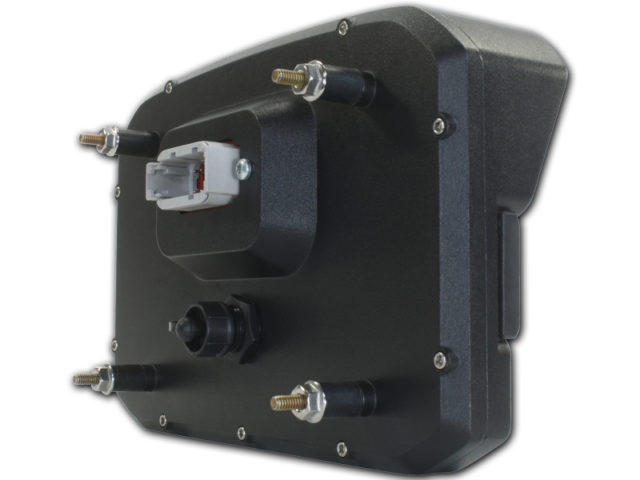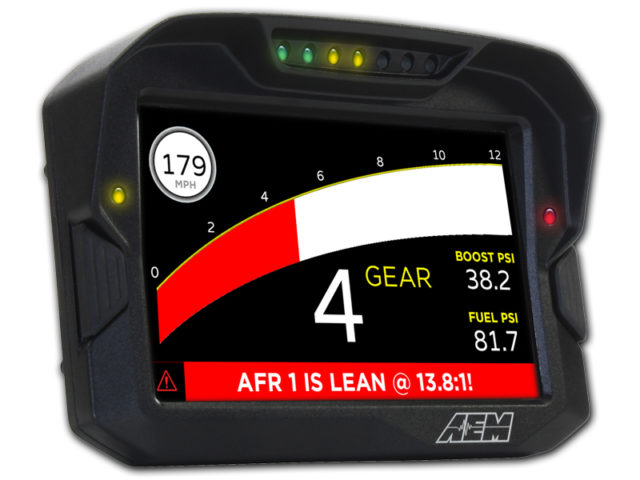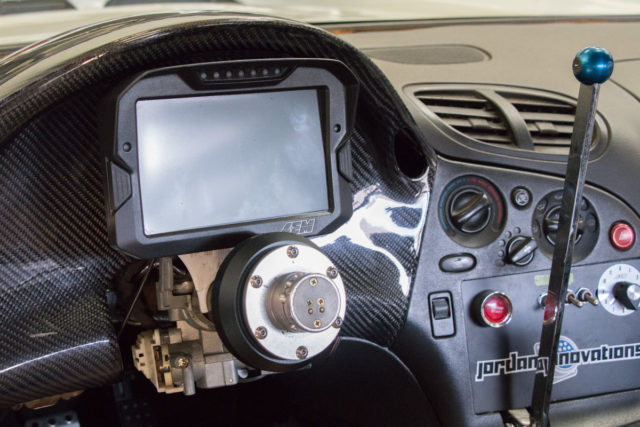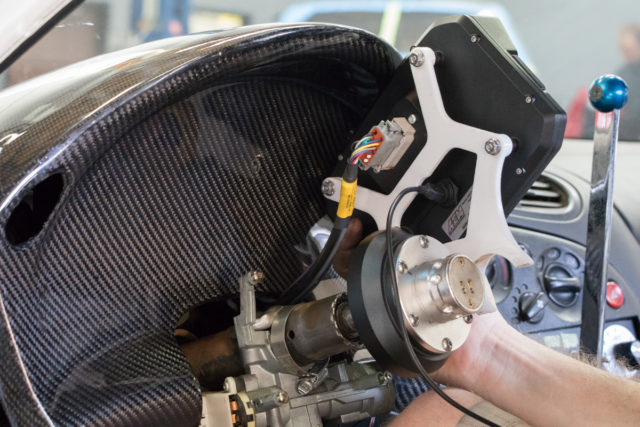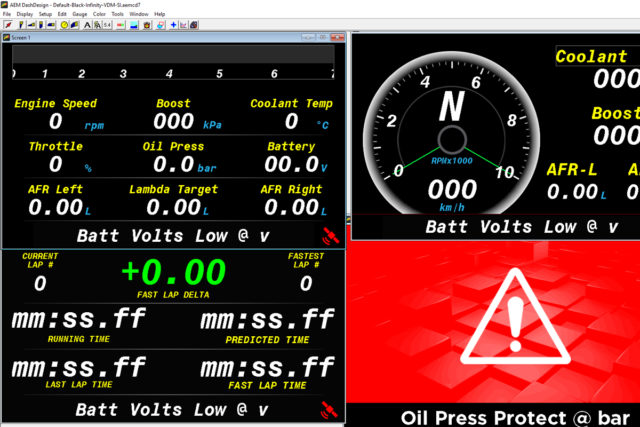A common problem you might face while building your car is how to display data from the engine, capture it, and be able to review it later. Even if you run a completely stripped down car on the track, most of us have the factory gauge cluster which is old, potentially broken, and cannot display all the required data you need to make sure your car is running its best. Sure you have the option of running gauge pods with aftermarket gauges, and sticking them throughout the cockpit of your seating position, but that can be expensive. Plus, now you’ve got a bunch of gauges all over feeding you tons of data, but what happens later when you need to review engine parameters and stats? You can’t because although you see real time updates from them, the data is gone the first time you look away. What you need is a way to display all engine parameters that you want, the way you want, while providing user programmable warnings and data logging.
What Solutions Do You Have?
Sounds simple, right? Well unfortunately it hasn’t really been so. Offerings from the various manufacturers have had limitations in one way or another. Some are difficult to install, offer limited user customization, provide poor data logging speeds, and leave no room for adding external sensors. AEM hopes to change that though, with the new CD-7 motorsports digital dash display. CD-7 stands for Can Display 7 inch, which is pretty self explanatory-Its got a bright direct sunlight readable 7 inch screen which displays information from the CAN bus, meaning you see everything the car sees and automatically log it to boot. We should note however, that there are two different variations of the CD-7 display, the CD-7 (MSRP $1,299) and CD-7L (MSRP $1,699), which denominates whether you want logging capability or not.
For those that choose the CD-7L with logging capability earn 200MB of room, 100Hz per channel, with individual log speed for each channel. This is fantastic news, as many offerings do not allow high speed data logging and quickly become bogged down and slow when trying to record multiple channels at a high speed. You can think about it like internet at your house–if you have slow internet and one user, it might not be too bad in terms of speed. Start adding in multiple people sharing the internet connection and now it’s bogged down and slow. Logging is the same thing for most devices, start watching more than a few engine parameters and you’ll find datalogs that are only updating a few times a second, or slower.
Since the CD-7L allows 100Hz speeds, and Hz speed adjustability you won’t ever need to worry about bottle-necking and lag in data logs. Users might be wondering why you wouldn’t need the fastest logging times for every parameter, but sometimes it isn’t necessary. For example, you might only need to log coolant temps at 1 Hz (or one time per second) but RPM, wheel speed, and engine timing would require more frequent records to give you a good idea of what’s going on with your car.
CD-7 In The Hands
When it comes to the screen and build quality, AEM took no shortcuts in designing a display that would hold up in the most grueling environments your vehicle will go through. Let’s start with the screen–it is NOT a touchscreen. AEM determined that in most race applications, users will have gloves on making it useless.
Customers tell us that they love being able to see the display regardless of how bright the sun is. –Lawson Mollica, AEM Performance Electronics
Additionally, there are seven shift lights across the top of the display, two warning lights on the side, along with one button on the left, and one button on the right of the screen. The rear features two connectors that are IP76 rated, allowing this to be used in boats, motorcycles, trucks, and cars in any environment that would normally impact the type of electronics you can reliably use.
The buttons on the side of the CD-7 are sealed as well, but most importantly offer expandability when the screen is mounted somewhere that is difficult to access, or when you need remote buttons installed more conveniently. Want to use steering wheel mounted buttons with the CD-7? The AEM CD-7 allows you to do that.
Because the AEM CD-7 is completely user adjustable, setting up alerts, warning lights or messages is very easy to do. Finding warning lights on similar devices is not uncommon, but too frequently there are so many LED’s that you don’t know what it’s referring to. Flashing red LED? Uh-oh. But why is it going off? The CD-7 can flash a red LED, turn on the oil temp light, and display a graphic telling you exactly what you need to know, leaving the guesswork aside.
AEM CD-7 Features
- Amazing 7 inch Full Color screen with 800×480 resolution
- 1000 cd/m2 brightness and anti-glare screen make it readable in all conditions
- IP66 water resistance rating
- Available with or without logging
- Seven programable pages including main, alarm, on-change, and start-up
- User programable alarm pages alert you to problems instantly
- Free DashDesign software to edit all screens
- Seven LED RPM/Shift light indicators which are user programmable
- Accepts channels from two separate user programmable CANbus connections
Alarms are a unique feature for this display, which provide drivers up to date information, and very obvious splash screens when necessary. For example, you can set up the CD-7 to switch to a solid red screen when oil temps exceed your preset limit. Gone are the days of not realizing a tiny warning light was on, or realizing that AFR’s were too lean, too late. The CD-7 allows you to set up the display exactly how you want to see it, and warn you to errors and issues when you want to see them, the way you want to see them. Don’t forget that not all alarms or warnings are bad–you can easily set up the CD-7 to let you know when coolant and tires are warmed up so you know when you can start pushing the car on the track.
AEM provides you with a default layout for gauges, but leaves the user interface, and buttons completely up to the user. There are multiple screens you can use while driving, and switching between them is easy as pressing a button.
But What About Install?
Jeff Jordan from Jordan Innovations came by our shop to show us how the installation was done on his LS-swapped RX-7. Excuse us, we should clarify – a supercharged LS, and every bit of the AEM CD-7 was taken advantage of to make sure this 700+ hp beast runs the way it should. First off, you’ll need to decide if you are keeping the factory gauge cluster. This will affect how you mount the CD-7, but you can always change this down the road. In our example, Jordan wasted no time pulling the factory cluster out, and began to show us how he 3D printed a nice little holder clamp which attaches to the steering column.
Speaking of 3D printing, the AEM CD-7 opens up a whole new ball game for mounting options too. Users of the CD-7 in higher end, less stripped down cars might be seeking an install look of the cleaner variety, and with 3D printing that is now possible. Scan the dashboard area, pull the factory cluster, and install the CD-7 digital display. Boom, that easy. Of course the majority of users will most likely not be using 3D printing, which is fine since the display has four mounting points on the rear along with vibration damping which should help those racecars with stiff suspension and trucks attacking baja trails.
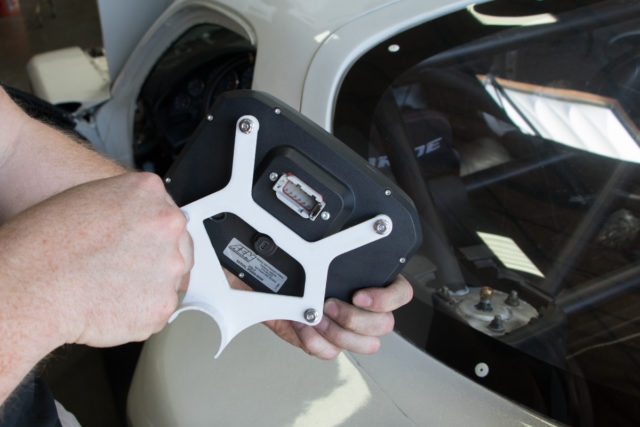
With 3D printing more easily accesible, creating a custom mount provides for endless installation options.
Once the factory cluster is out, Jordan proceeded to run the CANbus wire up through the back dashboard area with the CD-7 plug on the end. After ensuring that there is enough slack in the cable, the wire was zip-tied down to prevent it from falling out.
It, of course, communicates with our products, but it also works with literally hundreds of popular third party CAN bus devices. – Lawson Mollica, AEM Performance Electronics
Once installed, installation is as easy as tapping into the CANbus of your car. Since the AEM CD-7 is designed to pull data from all sensors in the car, the one connection makes installation a simple DIY project. If you’re just looking for a gauge cluster replacement, you might be done at this point as far as installation goes. However, you still have a plethora of menus and displays that you can go through and customize. Lucky for you, the folks over at AEM have left the CD-7 pretty much open, meaning custom layouts, gauge faces, and templates can be made from scratch or downloaded from other users.
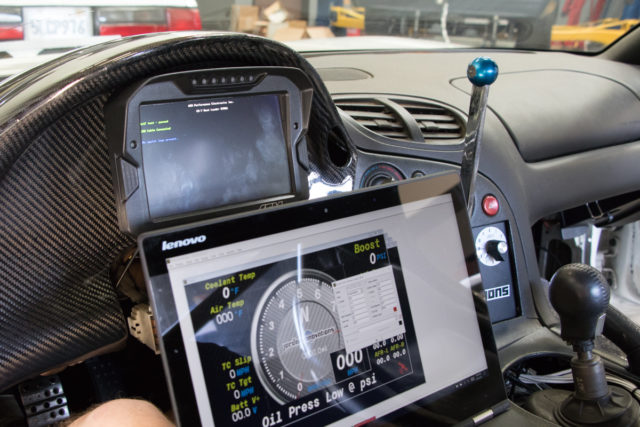
With the CD-7 plugged into the laptop, screen layout changes are easily made with the free software from AEM.
Using The Add-ons
This isn’t all the AEM CD-7 offers however. Optional equipment for the CD-7 include the Vehicle Dynamics Module (AEM P/N 30-2203, MSRP $375.00) which will allow timing, track mapping, lateral G, pitch, roll, and altitude to be combined with engine data logs. This is a huge step in the industry, as when you try and gather this much data, you usually end up with multiple devices saving all of this data in various formats that you then need to sync, combine, and sort.
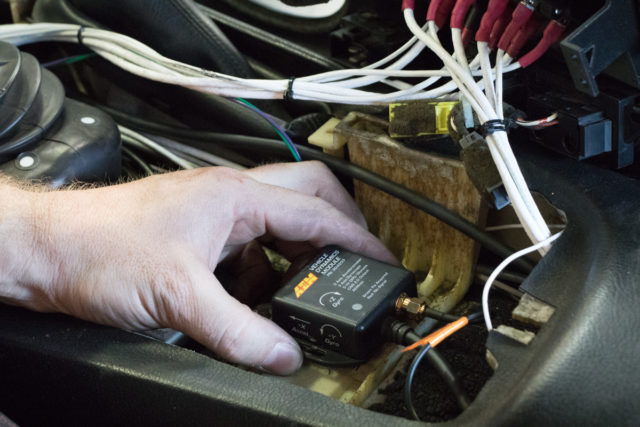
The Vehicle Dynamics Module was installed in the most central location of the car, right behind the shifter.
Since Jordan did have the VDM, we had the opportunity to see how that was installed as well. When using the Vehicle Dynamics Module, you must install it in as central a location of the car as possible, which will help provide accurate data from all the sensors inside of it. There are two things that connect to the VDM: a GPS antenna and a harness to connect to the CD-7. The GPS antenna must be installed with a clear view of the sky, and although through a window works, it is recommend to be on the outside of the car. The antenna itself is about a 1.5 inch x 1.5 inch flat square with a magnetic base that makes attachment easy. When set up properly, the VDM will provide you with the exact location and speed of your car, along with acceleration, braking, altitude, and g-force. With this data, you can compare wheel speed to actual vehicle speed (indicating wheel slip), track layout, and how quickly your car accelerates, brakes, turns, and even traction and stability control.
Using the data collected, you can calculate the exact percentage of wheel spin versus grip you need to accelerate fastest, and incorporate that into your tune or traction control. When it comes to stability, the VDM also reports the angle of the car, which could be compared against steering angle to determine when stability control (if your car is equipped) interferes with driving and how much. All of a sudden your racecar has all the features of a modern high-end sports car complete with data logging allowing you complete review after to figure out where to make improvements and drop lap times.
Achieving Your Own Look
With custom user screens, you can set up the AEM CD-7 graphs, gauges, and displays to look exactly how you want it to look without the need to purchase templates. Frequently you will find a company that tries to pitch a product as “user friendly” only to find out software is impossible to use without years of experience, or there is no support online. Both of those statements are made invalid after checking out the free software AEM offers, DashDesign.
DashDesign is a simple interface which will allow you to see all the gauges your CD-7 can offer, and provide on the fly changes to show you exactly what will be displayed. Want to see what a gauge will look like if you change it to blue? A few clicks of the mouse and you’re done. If you really want to get fancy, you can even upload your own images to use as splash screens, gauges, and warnings. “DANGER TO MANIFOLD” anyone? Once you’re finished, you can upload all the changes you’ve made to the CD-7 with a USB connection and enjoy your new layout immediately.
On top of that, AEM runs their own forums filled with users asking questions, providing tips, and sharing templates–pretty cool! While browsing through, we found plenty of users, unique templates, and even AEM Electronics support posting inside, ensuring you will receive the help you need to set up the CD-7 just how you want it.
Is It For You?
The AEM CD-7 is for everyone. Whether you’re trying to retrofit an older car with standard electronics, to centralize all the gauges in your race car, the CD-7 will work and grow with you. The easy, user friendly setup and design that is offered from the CD-7 makes sure that setup and programming are as easy as they come. Custom designed templates and layouts for the multiple gauge screens ensure that the screen is always displaying the data that you want to see, when you want to see it, and in a way that you want to see it. Throw in the addition of logging from the CD-7L, and performance review after the fact will allow you to see how the car is performing, and where improvements can be made by the driver. Immediate feedback from high performance engines is crucial on the track, and the capability of setting up alarms and notifications on screen will not only immediately identify problems, but help prevent small things from becoming catastrophic.
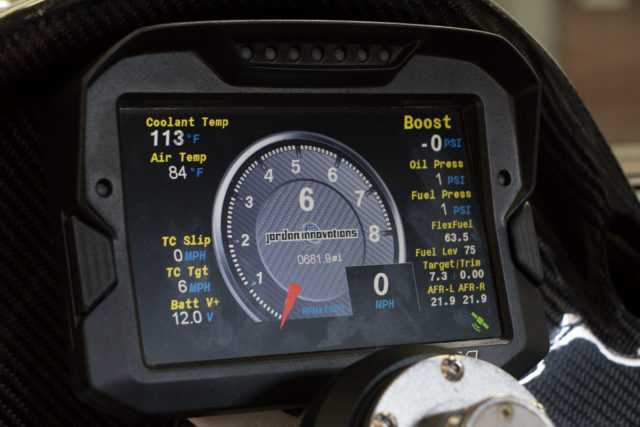
Customized dash screens are easy to upload, and enable you to place custom images, sponsors, or shop logos anywhere you want.
At the end of the day, the AEM CD-7 will provide you an intimate look at how your vehicle is performing, by combining all necessary gauges and readouts directly in front of you. You won’t need gauge pods all over, or separate sensors and senders for individual gauges. The user community is rather large for the CD-7, and sharing gauge layouts and templates is easy. While wrapping up some example templates on the computer during his visit, Jeff Jordan informed us, “…there is no similar display gauge currently offered that allows this level of customization and such clear indication of what’s happing (with your engine).” We would venture to guess that might be why we frequently see the CD-7 used in both street and full blown track vehicles. For more information, see AEM for full compatibility and updates.



